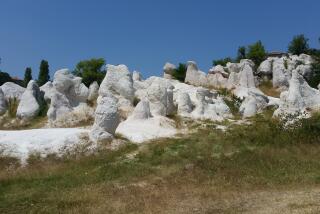HOORAY FORT LEE, N.J., BIRTHPLACE OF FILM : Thomas Edison, D. W. Griffith and Other Pioneers Made It the Hollywood of the Pre-WWI Movie Industry
- Share via
FORT LEE, N.J. — Film historian Thomas F. Hanlon stood outside the printing company plant that was Universal Studios before World War I, when this town was the film capital of the world.
“This is the only building still standing from that magical era. Yet few are aware of its historical significance,” Hanlon said.
Fort Lee, population 32,000, is a bedroom community for New York, connected to the Bronx by the George Washington Bridge over the Hudson River.
“Hundreds of films were produced in Fort Lee from 1903 to 1927, most during its heyday, 1908 to 1917,” Hanlon said. “But Fort Lee has been forgotten.
“Hardly anybody in New Jersey, New York, Hollywood or anywhere else outside this town realizes the importance of Fort Lee in the history of motion pictures. Everybody thinks it all happened in Hollywood.”
Hanlon, 66, who has lived in Fort Lee most of his life, produced a 45-minute documentary, “Before Hollywood There Was a Fort Lee.”
There were seven major film studios in Fort Lee. Twenty-one other film companies shot on location here.
D. W. Griffith directed several films here, including his first, “The Adventures of Dolly,” in 1908. Fort Lee was the location of Mary Pickford’s first film, “The Lonely Villa” in 1909, and several of her other pictures.
The Barrymores, Dorothy and Lillian Gish, Mae Marsh, Tom Mix, Charlie Chaplin, Will Rogers and other famous pre-World War I actors and actresses starred in films produced in Fort Lee.
It was here that Theda Bara made her vamp movies, and where the “Perils of Pauline” serials were filmed. Biograph’s first slapstick comedy, “Curtain Pole” starring Mack Sennett, was shot in Fort Lee. This is where the Keystone Kops started.
Blown-up stills from movies made here hang on the walls of the Fort Lee Public Library. The library has 1,000 stills from Fort Lee films and 30 prints of films made here.
“Why Fort Lee? Film making began in New Jersey,” said Rita Alomara, 35, Fort Lee Public Library librarian. “And Fort Lee had everything the film makers needed--fields, rolling hills, the Palisades on the Hudson, the river itself, woods, farms, the small-town setting--and it was close to Broadway where the actors came from.
“Every month we show a film produced in Fort Lee at the library, and a couple of times during the year we feature Tom Hanlon’s excellent documentary on the early days of movie-making.”
She wrote the 200-page illustrated book “Hollywood on the Palisades,” published in 1983, which lists 917 films made in Fort Lee, including casts and credits.
“There were many more films made here than those I’ve listed. But that was all I managed to find in the archives and memorabilia at the Fort Lee Library, from periodicals of that time and in my research at the New York Public Library, Museum of Modern Art and other sources,” she said.
She said only a few Fort Lee films exist. “They were printed on extremely flammable silver-nitrate film. Most were lost in studio fires or reprocessed to recover the valuable silver.
“The sad thing about Fort Lee is no one visiting the town would ever know it had been a filmmaking center unless they happened to come to the library. There are no signs proclaiming ‘America’s First Film Capital,’ no historic landmarks, no streets named D. W. Griffith or Pauline White or Mack Sennett, no local film festivals. . . .”
New Jersey is where the world of make-believe on the silver screen began.
Twenty-five miles southwest of Fort Lee, in West Orange, is the National Park Services’ Edison National Historic Site, the huge, red-brick Thomas A. Edison research laboratory complex.
It was in West Orange in 1888 that Edison began his experiments with motion pictures with the help of assistant William K.L. Dickson and others.
On Oct. 8, 1888, Edison wrote the U.S. Patent Office: “I am experimenting upon an instrument which does for the eye what the phonograph does for the ear, which is the recording and reproduction of things in motion. . . .”
On his return from a trip to Europe in 1889, he was met by Dickson at the lab where the movie experiments were going on in accordance with Edison’s instructions. Dickson dimmed the lights and cranked the first image ever flashed on a screen. It was footage of Dickson lifting his hat from his head, welcoming Edison home.
“Good morning, Mr. Edison,” said Dickson’s animated image on the wall. “Glad to see you back. I hope you are satisfied with the Kineto-phonograph.”
The first motion pictures were talkies, not silents, and were produced 38 years before Al Jolson appeared in “The Jazz Singer.”
Edison had difficulties synchronizing the sound system with a phonograph (another Edison invention) and a projector. So, after the inventor’s initial work with talkies, he concentrated on making silent films.
The earliest film in the Library of Congress archives is that of Edison’s walrus-mustached lab assistant John Ott sneezing in 1889.
In 1893 Edison built the Black Maria, the first motion-picture studio. The 50-by-18-foot tar-paper shack mounted on rollers on a circular track was called the Black Maria because it represented a paddy wagon of that time.
The roof could be opened up with pulleys to provide light--electric bulbs weren’t strong enough then. Workers pushed the studio around the track in line with the sun’s progress, to maintain adequate lighting during the film making.
Edison made hundreds of short one- and two-reel movies in the Black Maria, very few of which survive.
Originals of many of his motion-picture cameras, projectors and other movie equipment as well as many of his other inventions are on exhibit at the Edison Historic Site, including a 1954 replica of the Black Maria.
The first motion pictures ever released to the public were made in the Black Maria. These early 60-, 90- and 120-second films were viewed by one person at a time for a nickel each at Edison Kinetoscope Peep Shows.
Long lines gathered on lower Broadway in New York on April 14, 1894, to marvel at his latest invention. It wasn’t long before huge crowds were viewing the Edison movies in peep shows from coast to coast.
Two years later, on April 23, 1896, in a music hall on Herald Square, an auditorium full of people sat and watched several of Edison’s motion pictures on a big screen. There were movies of ballet dancers, boxing matches, waves crashing on a beach.
A new form of entertainment had arrived. The world would never be the same.
Edison had the patents. He had a corner on the film industry for several years, manufacturing motion-picture machines and producing the films.
His 1903, 14-minute movie “The Great Train Robbery,” directed by Edwin S. Porter, is considered the classical prototype of the motion-picture play. It’s shown daily at the historic site.
In 1912 the Edison Talking Picture Co. began distributing talkies through much of the world. Among the exhibits at the historic site are original theater show cards with still photographs from the early talkies.
“They laugh. They talk. They sing. The only genuine talking pictures,” the show cards proclaim.
“But there were a lot of bugs. The synchronization of the phonograph and the projector did not always mesh. Technical problems plagued the system,” said Edward J. Pershey, 37, curator.
“There was a disastrous fire in 1914 in Edison’s film-processing plant. Although the motion-picture division was Edison’s major money maker for a number of years, by 1916 the inventor quit the movie business.”
In the small town of Nutley, N.J., midway between Fort Lee and West Orange, lives Robert E. Lee, 74, founder-president of the Essex Film Club, which started in 1939 and claims to be the oldest film club in the United States.
Lee, too, is a noted film historian. A former radio station owner and announcer, he was a film editor for many years. He has his own 50-seat movie theater behind his home.
Among his collection of 400 feature films and 1,500 shorts, he has eight Edison originals. During a visit to Lee’s personal theater he showed a 1913 Edison talking picture entitled “Nursery Favorites.”
Many nursery favorites are sung by costumed singers in the film made 14 years before Jolson’s “Jazz Singer,” which many erroneously believe to be the first talkie ever made. The sound, synchronization and quality of the 1913 talkie are surprisingly good.
Five years ago Lee was commissioned by the state Department of Education to spend a year visiting schools and libraries throughout New Jersey to lecture on the beginnings of movie-making in the United States.
“It is amazing how many people here in New Jersey still do not know that this is where the motion picture originated,” Lee said.
Asked why the movie makers abandoned New Jersey and headed for California, Lee said:
“There are many reasons: to get out from under Edison’s efforts to keep a stranglehold on the industry, and the climate was so much better for film making in Southern California.
“When World War I came along, the government did not consider movies essential. The film companies could not get enough coal to heat their huge studios. That really helped chase them west. New Jersey folded its tent and the rest is history.”
More to Read
Only good movies
Get the Indie Focus newsletter, Mark Olsen's weekly guide to the world of cinema.
You may occasionally receive promotional content from the Los Angeles Times.










